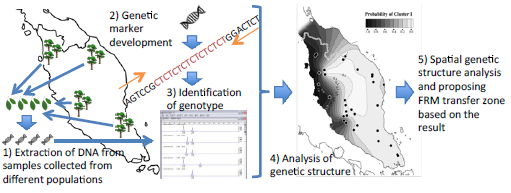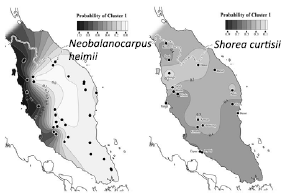Methods to establish transfer zones of forest reproductive materials in Peninsular Malaysia
Description
Uncontrolled transfer of forest reproductive materials (FRMs) has resulted to failures, sometimes taking many years to develop even after seemingly successful establishment. Failures, which should have been caused by less adaptation of transferred FRM to new environments, were often due to climatic, insect, or disease events that had much less impact on the native source. In uniform plantations, failures reduce the productivity of the new plantation, where better productivity is expected than in the previous plantation. Another problem arises in enrichment planting, which is commonly conducted in tropical rain forests in Southeast Asia. If transferred FRMs reach reproductive stage, they genetically contaminate the next generation through mating with native trees because enrichment planting is conducted in primary or secondary forests. Genetic contamination should not be ignored as the fitness of native forests in this region is affected when large volumes of transferred FRMs are introduced.
To avoid these problems, some methods have been proposed to establish FRM transfer zones. Provenance trials should provide the most reliable information for determining the limits of FRM movement and discerning which seed sources are best for planting locations. However, these trials have disadvantages and they are costly in terms of resources and time. If progeny test materials involve a few seed sources, then they can be used for assessing FRM transfer zones. Short-term common-garden studies, compared with field provenance trials, have the disadvantage of not evaluating seed sources during extreme climatic events and naturally occurring pest problems over time. However, they provide information about adaptation to environment expressed at the early stage of their growth. Although molecular markers are considered as neutral or nearly neutral against adaptation (selection), processes such as migration (movement of alleles among locations), population size, and genetic drift (random loss or fixation of alleles) affect the distribution of variation in molecular markers. There have been continuing discussions on how molecular markers are used for determining FRM transfer zones. Because the advantage of molecular markers are less time and labor, FRM transfer zones established by molecular markers should be considered tentative until confirmed by adaptive traits in a common environment (Fig. 1). Therefore, adaptive management should be introduced for FRM transfer zones based on molecular markers, which are going to be revised by the latest information on adaptive traits.
Because of the urgent necessity and the less time and labor it entails, we adopted the method of using molecular markers to establish FRM transfer zones. We analyzed the genetic structure of two important timber species in Peninsular Malaysia as examples. Genetic marker analysis has detected that the genetic diversity of Neobalanocarpus heimii (local name: chengal) was well explained when genetic diversity was separated as four different clusters. These four different clusters were localized at different regions in Peninsular Malaysia. When the localization of clusters was applied in determining the FRM transfer zone, four regions were recognized as FRM transfer zones. On the other hand, genetic marker analysis detected that the genetic diversity of Shorea curtisii (local name: seraya) was explained when genetic diversity was separated as three different clusters. These three different clusters, however, showed lower probability as regards cluster separation and showed ambiguous correspondence to localization in Peninsular Malaysia. This result supports the idea that strict regulation is not required for the species (Fig. 2). We must remember that the result was obtained using neutral genetic markers. If adaptive genetic variation is detected by long-term field provenance trial, medium-term progeny test, short-term common garden nursery and/or non-neutral genetic marker analysis in the future, then further revision of the regulation is required. Thus, FRM transfer zones should be determined for each important timber species in Peninsular Malaysia.
Figure, table
-
Fig. 1. Research flow showing the proposed forest reproductive material (FRM) transfer zones based on molecular markers
-
Fig. 2. Examples of two timber species, which showed distinct patterns of genetic structure, in Peninsular Malaysia
- Affiliation
-
Japan International Research Center for Agricultural Sciences Forestry Division
- Classification
-
Technical
- Research project
- Program name
- Term of research
-
FY 2014 (FY 2011-FY 2015)
- Responsible researcher
-
Tani Naoki ( Forestry Division )
KAKEN Researcher No.: 90343798Muhammad Norwati ( Forest Research Institute Malaysia )
Lee Soon Leong ( Forest Research Institute Malaysia )
Hong Ng Chin ( Forest Research Institute Malaysia )
Lee Hong Tnah ( Forest Research Institute Malaysia )
Ng Kevin Kit Siong ( Forest Research Institute Malaysia )
ORCID ID0000-0002-7810-7575Lee Chai Ting ( Forest Research Institute Malaysia )
Zakaria Nurul Farhanah ( Forest Research Institute Malaysia )
Tsumura Yoshihiko ( Forestry and Forest Products Research Institute )
KAKEN Researcher No.: 20353774 - ほか
- Publication, etc.
-
https://doi.org/ 10.1007/s12686-013-0100-9
Lee CT et al. (2014) Cons Genet Res 6:389-391.
https://doi.org/10.1111/mec.12243Ohtani M et al. (2013) Mol Ecol 22:2264-2279.
https://doi.org/10.1007/s12686-011-9546-9Ohtani M et al. (2012) Cons Genet Res 4:351-354.
https://doi.org/10.1007/s12686-009-9037-4Ng KKS et al. (2009) Cons Genet Res 1:153-157.
https://doi.org/10.1016/j.foreco.2009.07.029Tnah LH et al. (2009) Forest Ecol Manag 258:1918-1923.
- Japanese PDF
-
2014_C07_A3_ja.pdf456.67 KB
2014_C07_A4_ja.pdf368.25 KB
- English PDF
-
2014_C07_A3_en.pdf420.67 KB
2014_C07_A4_en.pdf449.27 KB
- Poster PDF
-
2014_C07_poster.pdf420.15 KB


